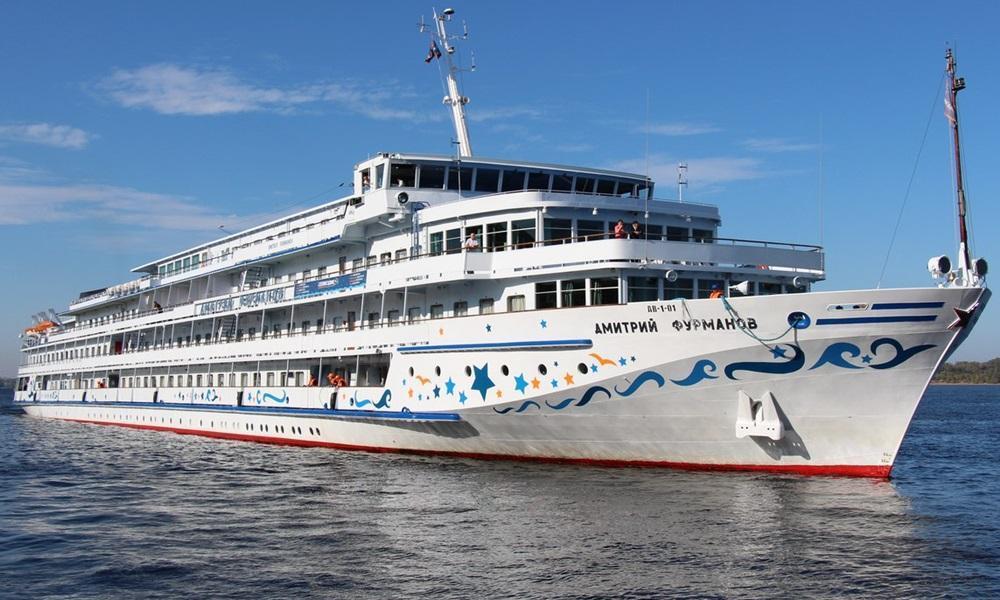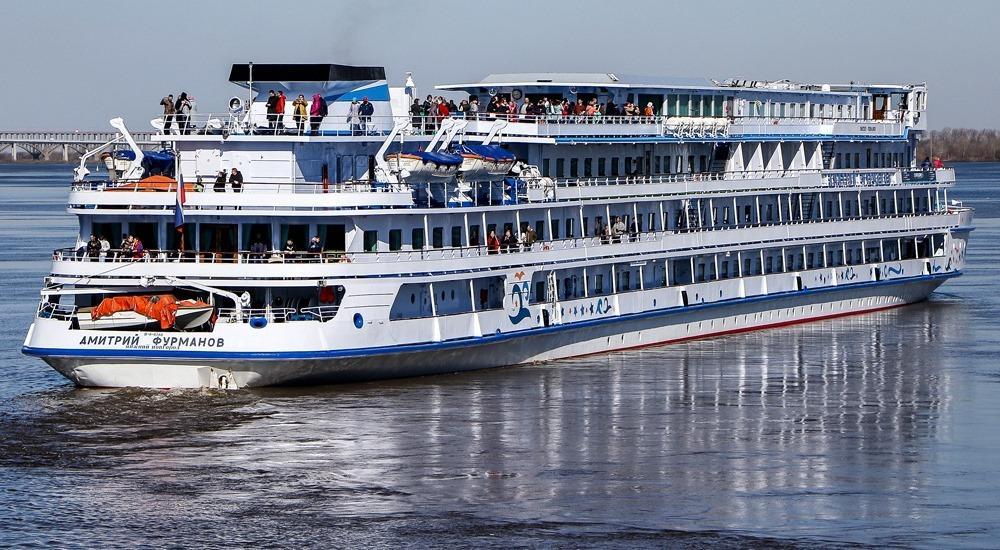MS Dmitry Furmanov
MS Dmitry Furmanov last position
The last location of MS Dmitry Furmanov is in Russia Inland cruising en route to KAZ. The AIS position was last reported 1 month ago.
Current PositionSpecifications of MS Dmitry Furmanov
| Year of build | 1983 / Age: 42 |
| Flag state | Russia |
| Builder | VEB Elbewerften Boizenburg (Rosslau, Germany) |
| Class | USSR Russian cruise ship (Project 302) |
| Ferry route / homeports | Moscow |
| Speed | 14 kn / 26 km/h / 16 mph |
| Length (LOA) | 129 m / 423 ft |
| Beam (width) | 17 m / 56 ft |
| Gross Tonnage | 5500 gt |
| Passengers | 285 |
| Crew | 95 |
| Decks | 5 |
| Cabins | 140 |
| Decks with cabins | 4 |
| Last Refurbishment | 2016 |
| Sister-ships | Dmitriy Furmanov-class |
| Owner | Kama Tri Shipping Co Ltd |
| Operator | Infoflot (Russia) |
MS Dmitry Furmanov Review
Review of MS Dmitry Furmanov
MS Dmitry Furmanov cruise ship ("теплоход Дмитрий Фурманов" круизный корабль) is a traditional Russian river passenger vessel built for the USSR (Soviet Union) in the GDR (Eastern Germany). MS Furmanov cruises on the Volga River, offering roundtrips from Moscow and Nizhny Novgorod, as well as itineraries between Moscow and St Petersburg.

The vessel is owned by "Kama Tri Shipping" and operated under charter by the St Petersburg-based company Infoflot (Инфофлот). Infoflot functions as both a tour operator and travel agency, offering Russian and international river and ocean cruise programs.

The ship is named after Bolshevik commissar Dmitriy Andreyevich Furmanov (1891–1926), author of the famous novel "Chapayev" about Red Army hero Vasily Chapayev. The vessel was last refurbished in 2016. Part of the Project 302 series, a total of 28 ships were built between 1983 and 1992. All feature diesel-electric propulsion with three propellers and were originally designed to accommodate up to 332 passengers.
Cabins
MS Furmanov has a total of 140 staterooms, including 2 Two-Room Suites and 4 Junior Suites with Balconies. Other accommodations include 10 Singles (category A1), 11 Quads (category A4, also available as Triples/category A3), and 113 Twins (category A2, some convertible to Triples).
All cabins are air-conditioned and heated. Standard amenities include individually controlled air-conditioning, refrigerator, intercom phone, radio, flat-screen TV (with satellite reception), and an en-suite bathroom (WC, shower, washbasin, hairdryer, towels, and toiletries). Each cabin has an opening window, except those on the Lower Deck, which have portholes. Suites also feature a cabinet, coffee table with armchairs, dining table, double bed, single or double sofa bed (for 3rd–4th guests), floor lamps, a bathroom with a glass-door shower, and a step-out balcony furnished with a table and two chairs.
Cabin TVs provide Russian channels, recorded films and cartoons, live views from a bow-mounted camera, an emergency instruction channel, and a ship information channel displaying the itinerary map and current position.
Shipboard Dining and Entertainment
Onboard facilities include:
- Sun Deck: Solarium with loungers, deckchairs, tables, and a giant chess set; indoor Theater (Cinema / Silent Disco / Conference Hall / Dance Lounge / Bar); outdoor Gym with fitness equipment.
- Boat Deck: Music Salon (Main Lounge / Piano Bar), Volga Restaurant (Bar-Restaurant), and Coffee Station.
- Middle Deck: Cafe Bar (Patisserie), Kama Restaurant (Dining Room), Library (Reading Lounge), and Boutique (Souvenir Shop).
- Main Deck: Medical Room (Infirmary), Beauty Salon (Hairdresser and Barber), Spa (Massage Room), Shop, Lobby (Reception / Guest Services Desk / Cruise Director’s Office / Tour Desk), Arts Room, Coffee Station, and Ironing Room (Laundry Service).
- Lower Deck: Sauna Room, Kids Room (Indoor Playground), Fitness Room (Gym), and Crew Quarters.
Shipboard activities include:
- The Theater serves as a Cinema, Conference Hall, Concert Hall, Dance Lounge, and Disco with its own Bar. It hosts Infoflot’s enrichment programs—lectures and multimedia presentations on Russian history and culture, as well as port talks by professional guides. Guests can participate in traditional tea ceremonies, Russian language lessons, dance and singing classes, music masterclasses, blini and vodka tastings, and live performances (classical, jazz, and Russian folk). A nightly silent disco is also featured.
- Volga Restaurant is a dinner-only venue offering an à la carte menu.
- Music Salon serves as the ship’s Main Lounge (Piano Bar) with a full-service bar, dance floor, grand piano, and live performances of classical, chamber, jazz, and blues music.
- Cafe Bar (Patisserie / Coffee House) offers specialty coffees and gourmet desserts.
- Arts Salon hosts complimentary arts and crafts workshops, including matryoshka (nesting doll) painting classes.
- Kids Room is a supervised indoor play area for children aged 2–12.
- On the Main, Middle, and Boat decks, 24-hour Coffee Stations provide complimentary drinks and snacks (coffee, tea, milk, cocoa, and cookies).
- Both restaurants serve buffet breakfast and waiter-served lunch and dinner featuring Russian cuisine. European dishes are also available on longer voyages. Three daily meals are included in the cruise fare. Dietary and vegetarian options are available, along with complimentary beverages such as champagne at breakfast and wine or vodka at dinner. Herbal teas and oxygen cocktails are also served.
- The ship offers free Wi-Fi, morning exercise sessions, yoga and pilates classes (led by a professional instructor), sports training, bicycle rentals, and a covered Solarium.
- All shore excursions are guided, and most are included in the cruise fare.
Note: You can view CruiseMapper’s complete list of river cruise ships and riverboats in the “Itinerary” section of our River Cruises hub. All companies and their fleets are listed there.
Other Infoflot cruise ships
MS Dmitry Furmanov Wiki
MS Furmanov is the first of Russia’s signature "Project 302" river cruise ships.
Dmitriy Furmanov-class Russian river ships
The "Dmitriy Furmanov class" (also known as "Project 302") consists of four series of Russian river cruise ships built in the GDR (Eastern Germany) for the USSR (Soviet Union) between 1983 and 1992. The class name honors Russian writer Dmitriy Andreyevich Furmanov (1891–1926), who also served as a Bolshevik commissar (Red Army officer).
These 27 river cruise ships were all constructed by VEB Elbewerft Boizenburg and represent an upgraded and larger version of the Project 301 (Vladimir Ilyich-class) vessels. They were used for passenger cruises in northwestern parts of the USSR—on the Volga, Belomorkanal, Lake Onega, Volga–Don Canal, Kama, and Amur rivers—as well as on the Dnieper River (Ukraine), in the Black Sea (coastal routes), and on China’s Yangtze River. Following the USSR’s collapse in 1991, all ships were acquired by private (Russian and foreign) companies.

"Project 302" ship technology
"Project 302" ships have the following specifications:
- LOA: 129 m (423 ft)
- Beam: 17 m (55 ft)
- DWT: 3852 tons
- V-shaped hulls that vary by series in exterior details such as window shape (rectangular or rounded) and wheelhouse lights
- Five decks (four passenger decks)
- Original capacity: 332 passengers and 98 crew members
- All cabins are outside (1-, 2-, or 3-bed), and facilities originally included two restaurants (180 and 80 seats), a café bar (79 seats, with dance floor), two bar lounges, cinema (102 seats), music hall with bar (75 seats), observation lounge with bar (75 seats), sauna, souvenir shop, hair salon, massage room, library, hospital (first-aid room), and a 360-degree promenade deck (with 100 outdoor seats and sports area)
- Powered by three 4-stroke marine diesel engines ("Viertakt-Dieselmotor," model 6ЧРН 36/45 / ЭГ70-5), each with a turbocharger
- Propulsion includes three bow thrusters
- Total power output: 2.2 MW
- Cabins include single, double, and quad types (originally 1-, 2-, or 3-bed) with private bathrooms
- After reconstruction, ships were fitted with larger cabins (including suites) and quads with two upper Pullman-style berths
- All vessels were later modernized and completely refurbished for both domestic and international cruise operators. During multi-million-dollar drydock refits, passenger capacity was reduced to enhance comfort and safety.
Project 302 ships
The first series of Project 302 includes:
- Dmitriy Furmanov (1983, Дмитрий Фурманов)
- Akademik Viktor Glushkov (1983, now Igor Stravinsky / Игорь Стравинский)
- Novikov-Priboy (1983, now Sergei Rachmaninov)
- Aleksey Surkov (1984, now Viking Helgi)
- Konstantin Simonov (1984, Константин Симонов)
- Leonid Sobolev (1985, Леонид Соболев)
- Mikhail Sholokhov (1985, Михаил Шолохов)
The second series includes:
- Aleksey Vatchenko (1985, now Ivan Bunin)
- Yuriy Andropov (1986, Юрий Андропов)
- Zosima Shashkov (1986, Зосима Шашков)
- General Vatutin (1986, Генерал Ватутин)
- MS Russ (1987, Русь)
- MS Lenin (1987, Ленин)
- Sergey Kirov (1987, now Viking Truvor)
- Marshal Rybalko (1988, now Zirka Dnipra / Dnieper Princess)
- Marshal Koshevoy (1988, now Viking Akun)
- Georgy Chicherin (1988, Георгий Чичерин)
- Leonid Krasin (1989, Леонид Красин)
- Nikolay Bauman (1989, now Knyazhna Anastasia)
- General Lavrinenkov (1990, Генерал Лавриненков)
- Narkom Pakhomov (1990, now Viking Ingvar)
The third series includes:
- Gleb Krzhizhanovskiy (1990, Глеб Кржижановский)
- Maxim Litvinov (1991, Максим Литвинов)
The fourth (final) series includes:
- Taras Shevchenko (September 1991, now TG Shevchenko)
- Konstantin Stanyukovich (October 1991, now Princess Jeannie / Xian Ni, Regal China Cruises)
- Arkadiy Gaydar (November 1991, now Princess Sheena / Xian Na, Regal China Cruises)
- Aleksandr Grin (December 1991, now Princess Elaine / Xian Ting, Regal China Cruises)
- Vladimir Vysotsky (planned, hull built in 1996, launched in 2003 as "Ocean Diva Original")

